Product Info Summary
| SKU: | A01238-2 |
|---|---|
| Size: | 100 μg/vial |
| Reactive Species: | Human, Mouse, Rat |
| Host: | Rabbit |
| Application: | ELISA, Flow Cytometry, IF, IHC, ICC, WB |
Customers Who Bought This Also Bought
Product info
Product Name
Anti-Lamin B Receptor/LBR Antibody Picoband®
View all Lamin B Receptor Antibodies
SKU/Catalog Number
A01238-2
Size
100 μg/vial
Form
Lyophilized
Description
Boster Bio Anti-Lamin B Receptor/LBR Antibody Picoband® catalog # A01238-2. Tested in ELISA, Flow Cytometry, IF, IHC, ICC, WB applications. This antibody reacts with Human, Mouse, Rat. The brand Picoband indicates this is a premium antibody that guarantees superior quality, high affinity, and strong signals with minimal background in Western blot applications. Only our best-performing antibodies are designated as Picoband, ensuring unmatched performance.
Storage & Handling
Store at -20˚C for one year from date of receipt. After reconstitution, at 4˚C for one month. It can also be aliquotted and stored frozen at -20˚C for six months. Avoid repeated freeze-thaw cycles.
Cite This Product
Anti-Lamin B Receptor/LBR Antibody Picoband® (Boster Biological Technology, Pleasanton CA, USA, Catalog # A01238-2)
Host
Rabbit
Contents
Each vial contains 4mg Trehalose, 0.9mg NaCl, 0.2mg Na2HPO4, 0.05mg NaN3.
Clonality
Polyclonal
Isotype
Rabbit IgG
Immunogen
E.coli-derived human Lamin B Receptor/LBR recombinant protein (Position: H102-F209).
*Blocking peptide can be purchased. Costs vary based on immunogen length. Contact us for pricing.
Cross-reactivity
No cross-reactivity with other proteins.
Reactive Species
A01238-2 is reactive to LBR in Human, Mouse, Rat
Reconstitution
Add 0.2ml of distilled water will yield a concentration of 500ug/ml.
Observed Molecular Weight
65-71 kDa
Calculated molecular weight
123799 MW
Background of Lamin B Receptor
Lamin-B receptor is a protein, and in humans, it is encoded by the LBR gene. It is mapped to 1q42.12. The protein encoded by this gene belongs to the ERG4/ERG24 family. It localized in the nuclear envelope inner membrane and anchors the lamina and the heterochromatin to the membrane. It may mediate interaction between chromatin and lamin B. Mutations of this gene has been associated with autosomal recessive HEM/Greenberg skeletal dysplasia. Alternative splicing occurs at this locus and two transcript variants encoding the same protein have been identified.
Antibody Validation
Boster validates all antibodies on WB, IHC, ICC, Immunofluorescence, and ELISA with known positive control and negative samples to ensure specificity and high affinity, including thorough antibody incubations.
Application & Images
Applications
A01238-2 is guaranteed for ELISA, Flow Cytometry, IF, IHC, ICC, WB Boster Guarantee
Assay Dilutions Recommendation
The recommendations below provide a starting point for assay optimization. The actual working concentration varies and should be decided by the user.
Western blot, 0.1-0.5μg/ml
Immunohistochemistry (Paraffin-embedded Section), 0.5-1μg/ml
Immunocytochemistry/Immunofluorescence, 2μg/ml
Flow Cytometry (Fixed), 1-3μg/1x106 cells
ELISA, 0.1-0.5μg/ml
Positive Control
WB: human placenta tissue, human HL-60 whole cell, human K562 whole cell, human THP-1 whole cell, human HEK293 whole cell, human U2OS whole cell, human U-937 whole cell, human Caco-2 whole cell,, rat thymus tissue, rat spleen tissue, rat testicular tissue, mouse thymus tissue, mouse stomach tissue, mouse testicular tissue, mouse SP20 whole cell,
IHC: human lung cancer tissue
ICC/IF: U20S cell
FCM: U20S cell
Validation Images & Assay Conditions
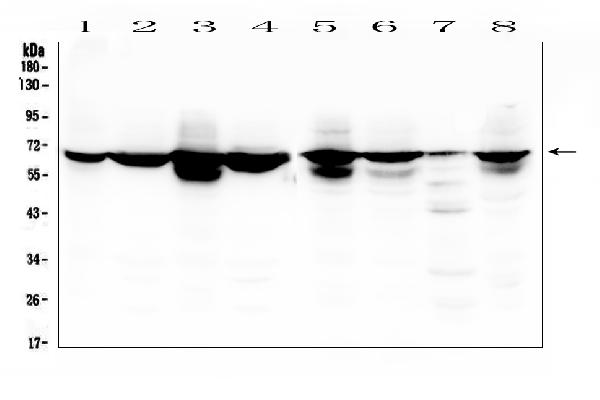
Click image to see more details
Figure 1. Western blot analysis of LBR using anti-LBR antibody (A01238-2).
Electrophoresis was performed on a 5-20% SDS-PAGE gel at 70V (Stacking gel) / 90V (Resolving gel) for 2-3 hours. The sample well of each lane was loaded with 50ug of sample under reducing conditions.
Lane 1: human placenta tissue lysates
Lane 2: human HL-60 whole cell lysates
Lane 3: human K562 whole cell lysates
Lane 4: human THP-1 whole cell lysates
Lane 5: human HEK293 whole cell lysates
Lane 6: human U2OS whole cell lysates
Lane 7: human U-937 whole cell lysates
Lane 8: human Caco-2 whole cell lysates
After Electrophoresis, proteins were transferred to a Nitrocellulose membrane at 150mA for 50-90 minutes. Blocked the membrane with 5% Non-fat Milk/ TBS for 1.5 hour at RT. The membrane was incubated with rabbit anti-LBR antigen affinity purified polyclonal antibody (Catalog # A01238-2) at 0.5 μg/mL overnight at 4°C, then washed with TBS-0.1%Tween 3 times with 5 minutes each and probed with a goat anti-rabbit IgG-HRP secondary antibody at a dilution of 1:10000 for 1.5 hour at RT. The signal is developed using an Enhanced Chemiluminescent detection (ECL) kit (Catalog # EK1002) with Tanon 5200 system. A specific band was detected for LBR at approximately 65-71KD. The expected band size for LBR is at 71KD.
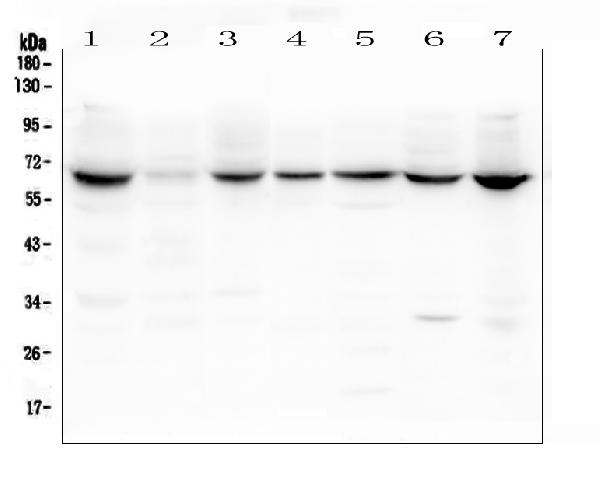
Click image to see more details
Figure 2. Western blot analysis of LBR using anti-LBR antibody (A01238-2).
Electrophoresis was performed on a 5-20% SDS-PAGE gel at 70V (Stacking gel) / 90V (Resolving gel) for 2-3 hours. The sample well of each lane was loaded with 50ug of sample under reducing conditions.
Lane 1: rat thymus tissue lysates
Lane 2: rat spleen tissue lysates
Lane 3: rat testicular tissue lysates
Lane 4: mouse thymus tissue lysates
Lane 5: mouse stomach tissue lysates
Lane 6: mouse testicular tissue lysates
Lane 7: mouse SP20 whole cell lysates
After Electrophoresis, proteins were transferred to a Nitrocellulose membrane at 150mA for 50-90 minutes. Blocked the membrane with 5% Non-fat Milk/ TBS for 1.5 hour at RT. The membrane was incubated with rabbit anti-LBR antigen affinity purified polyclonal antibody (Catalog # A01238-2) at 0.5 μg/mL overnight at 4°C, then washed with TBS-0.1%Tween 3 times with 5 minutes each and probed with a goat anti-rabbit IgG-HRP secondary antibody at a dilution of 1:10000 for 1.5 hour at RT. The signal is developed using an Enhanced Chemiluminescent detection (ECL) kit (Catalog # EK1002) with Tanon 5200 system. A specific band was detected for LBR at approximately 65-71KD. The expected band size for LBR is at 71KD.
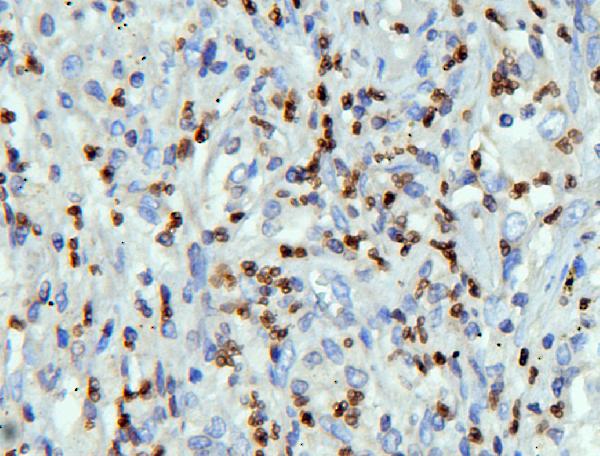
Click image to see more details
Figure 3. IHC analysis of LBR using anti-LBR antibody (A01238-2).
LBR was detected in paraffin-embedded section of human lung cancer tissues. Heat mediated antigen retrieval was performed in citrate buffer (pH6, epitope retrieval solution) for 20 mins. The tissue section was blocked with 10% goat serum. The tissue section was then incubated with 1μg/ml rabbit anti-LBR Antibody (A01238-2) overnight at 4°C. Biotinylated goat anti-rabbit IgG was used as secondary antibody and incubated for 30 minutes at 37°C. The tissue section was developed using Strepavidin-Biotin-Complex (SABC)(Catalog # SA1022) with DAB as the chromogen.
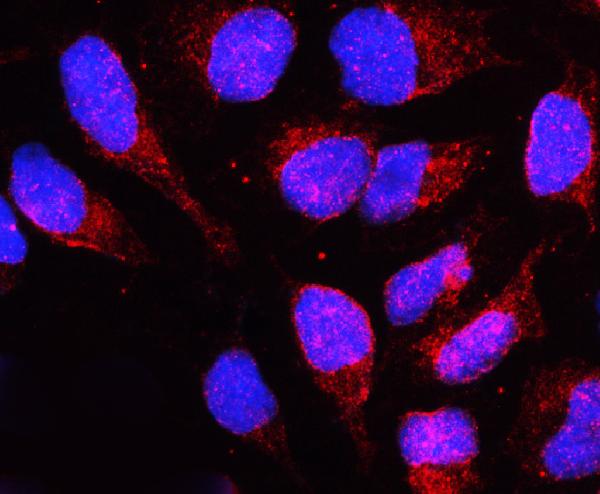
Click image to see more details
Figure 4. IF analysis of LBR using anti-LBR antibody (A01238-2).
LBR was detected in immunocytochemical section of U20S cells. Enzyme antigen retrieval was performed using IHC enzyme antigen retrieval reagent (AR0022) for 15 mins. The cells were blocked with 10% goat serum. And then incubated with 2μg/mL rabbit anti-LBR Antibody (A01238-2) overnight at 4°C. Cy3 Conjugated Goat Anti-Rabbit IgG (BA1032) was used as secondary antibody at 1:100 dilution and incubated for 30 minutes at 37°C. The section was counterstained with DAPI. Visualize using a fluorescence microscope and filter sets appropriate for the label used.
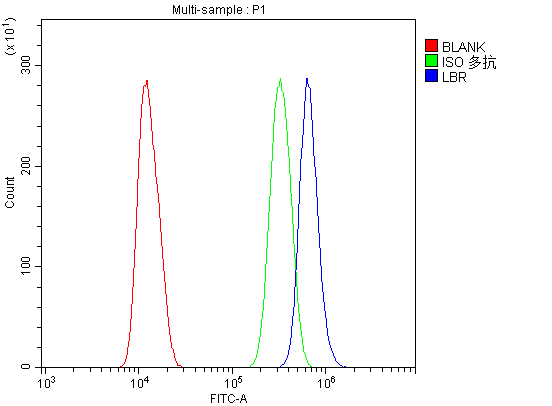
Click image to see more details
Figure 5. Flow Cytometry analysis of U20S cells using anti-LBR antibody (A01238-2).
Overlay histogram showing U20S cells stained with A01238-2 (Blue line). To facilitate intracellular staining, cells were fixed with 4% paraformaldehyde and permeabilized with permeabilization buffer. The cells were blocked with 10% normal goat serum. And then incubated with rabbit anti-LBR Antibody (A01238-2, 1μg/1x106 cells) for 30 min at 20°C. DyLight®488 conjugated goat anti-rabbit IgG (BA1127, 5-10μg/1x106 cells) was used as secondary antibody for 30 minutes at 20°C. Isotype control antibody (Green line) was rabbit IgG (1μg/1x106) used under the same conditions. Unlabelled sample without incubation with primary antibody and secondary antibody (Red line) was used as a blank control.
Protein Target Info & Infographic
Gene/Protein Information For LBR (Source: Uniprot.org, NCBI)
Gene Name
LBR
Full Name
Delta(14)-sterol reductase LBR
Weight
123799 MW
Superfamily
ERG4/ERG24 family
Alternative Names
Lamin-B receptor; Integral nuclear envelope inner membrane protein; LMN2R; LBR LBR C14SR, DHCR14B, LMN2R, PHA, PHASK, TDRD18 lamin B receptor delta(14)-sterol reductase LBR|3-beta-hydroxysterol Delta (14)-reductase|C-14 sterol reductase|delta-14-SR|integral nuclear envelope inner membrane protein|sterol C14-reductase|tudor domain containing 18
*If product is indicated to react with multiple species, protein info is based on the gene entry specified above in "Species".For more info on LBR, check out the LBR Infographic

We have 30,000+ of these available, one for each gene! Check them out.
In this infographic, you will see the following information for LBR: database IDs, superfamily, protein function, synonyms, molecular weight, chromosomal locations, tissues of expression, subcellular locations, post-translational modifications, and related diseases, research areas & pathways. If you want to see more information included, or would like to contribute to it and be acknowledged, please contact [email protected].
Specific Publications For Anti-Lamin B Receptor/LBR Antibody Picoband® (A01238-2)
Hello CJ!
A01238-2 has been cited in 2 publications:
*The publications in this section are manually curated by our staff scientists. They may differ from Bioz's machine gathered results. Both are accurate. If you find a publication citing this product but is missing from this list, please let us know we will issue you a thank-you coupon.
Zhu X,Mao Y,Guo M,Yu H,Hao L,Hua Q,Lu Z,Hong M,An F.Enhancement of anti-acne effect of Scutellaria baicalensis extract by fermentation with symbiotic fungus Penicillium decumbens.J Biosci Bioeng.2020 Nov; 130(5):457-463.doi:10.1016/j.jbiosc.2020.06.008.Ep
Species: Human,P. acne
A01238-2 usage in article: APP:WB, SAMPLE:THP-1 CELLS TREATED WITH P.ACNES, DILUTION:NA
Tan J,Luo J,Meng C,Jiang N,Cao J,Zhao J. Syringin exerts neuroprotective effects in a rat model of cerebral ischemia through the FOXO3a/NF-κB pathway. Int Immunopharmacol.2020 Dec 11;90:107268.doi:10.1016/j. intimp.2020.107268.Epub ahead of print.PMID:333
Species: Rat
A01238-2 usage in article: APP:WB, SAMPLE:CEREBRAL CORTEX, DILUTION:NA
Recommended Resources
Here are featured tools and databases that you might find useful.
- Boster's Pathways Library
- Protein Databases
- Bioscience Research Protocol Resources
- Data Processing & Analysis Software
- Photo Editing Software
- Scientific Literature Resources
- Research Paper Management Tools
- Molecular Biology Software
- Primer Design Tools
- Bioinformatics Tools
- Phylogenetic Tree Analysis
Customer Reviews
Have you used Anti-Lamin B Receptor/LBR Antibody Picoband®?
Submit a review and receive an Amazon gift card.
- $30 for a review with an image
0 Reviews For Anti-Lamin B Receptor/LBR Antibody Picoband®
Customer Q&As
Have a question?
Find answers in Q&As, reviews.
Can't find your answer?
Submit your question
1 Customer Q&As for Anti-Lamin B Receptor/LBR Antibody Picoband®
Question
We are currently using anti-Lamin B Receptor/LBR antibody A01238-2 for rat tissue, and we are content with the ELISA results. The species of reactivity given in the datasheet says human, mouse, rat. Is it possible that the antibody can work on goat tissues as well?
K. Wu
Verified customer
Asked: 2015-12-15
Answer
The anti-Lamin B Receptor/LBR antibody (A01238-2) has not been tested for cross reactivity specifically with goat tissues, though there is a good chance of cross reactivity. We have an innovator award program that if you test this antibody and show it works in goat you can get your next antibody for free. Please contact me if I can help you with anything.
Boster Scientific Support
Answered: 2015-12-15





